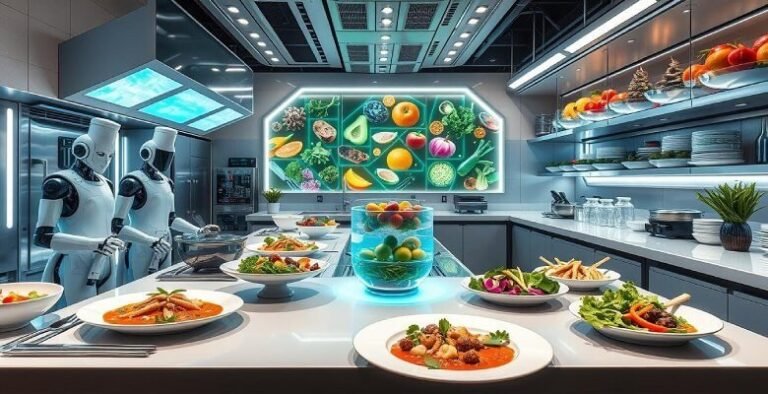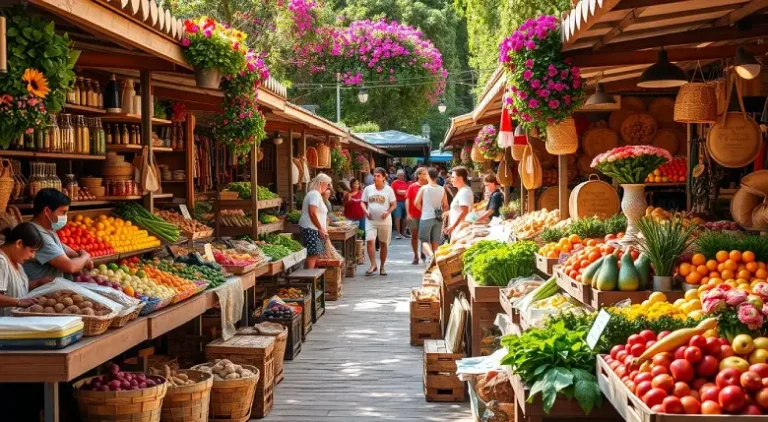Redefining Gastronomy: Emerging Trends and Techniques for 2025 and Beyond
Table of Contents
By 2025, more people will want to eat locally to help the planet. This change will make food more sustainable and innovative. You’ll see more plant-based dishes, seafood from sustainable sources, and new drinks that don’t have alcohol.
Key Takeaways
- The demand for locally-sourced ingredients is expected to increase significantly by 2025, driving the future of gastronomy towards sustainability.
- Culinary trends 2025 will focus on eco-friendly practices, reduced waste, and creative non-alcoholic beverage pairings.
- Food innovation will play a key role in the future of gastronomy, with a focus on plant-based options and sustainably-sourced seafood.
- Technology, like AI and IoT, will make dining better and help with meal planning and prep.
- The market for functional foods and drinks will grow, focusing on wellness and personalized nutrition.
- Bold global flavors and new cooking methods will become more popular, changing modern cooking.
- The trend of ‘Food Culture – Tradition Reinvented’ will highlight the mix of old and new in food, shaping the future of gastronomy.
The Evolution of Modern Culinary Practices
Exploring the world of food, you’ll see a big change towards new cooking ways. The forecast for 2025 shows a focus on making things better, with trends growing. This change is led by new, creative, and green food ideas.
Recently, people have started to like plant-based foods more. Chefs say 2025 will bring more Italian tastes, tasty drinks, and plant-based foods. This move towards healthier and greener food is expected to grow, with more people wanting food that’s good for the planet.
Some big trends for 2025 include:
- More focus on local and green ingredients
- More demand for plant-based foods and new cooking ways
- More efforts to cut down on food waste and be eco-friendly
The food world is always changing, and 2025 will likely bring even more new cooking ideas. Thanks to digital tech and social media, chefs can share their work and connect with fans in cool ways. Whether you love food or are just starting to explore, 2025 looks like it will be a thrilling time for food lovers.
Future of Gastronomy: Pioneering Technologies Reshaping the Kitchen
Exploring the future of gastronomy reveals a kitchen transformed by new technologies. Modern cooking methods are changing how chefs make dishes. By 2025, food tech will greatly change the food industry.
Social media is also shaping food trends. Platforms like Instagram and TikTok are influencing what people want to eat. Restaurants use these platforms to show off their dishes and connect with customers.
Some modern cooking techniques include:
- Lab-grown meat production, which is expected to grow by 25% annually over the next decade
- Plant-based cuisine options, now on about 60% of restaurant menus worldwide
- Fermentation and pickling techniques, up 25% in popularity last year
These food tech advancements are changing cooking and our food views. Quantum computing is being researched by IBM and Google. This could lead to new food tech uses, making food production more efficient and sustainable.
The food industry is evolving fast. Gastronomic innovations and modern cooking techniques are key to its future. With technology and social media, we can expect more exciting food and cooking developments.
| Year | Gastronomic Innovations | Modern Cooking Techniques |
|---|---|---|
| 2023 | Lab-grown meat production | Fermentation and pickling techniques |
| 2025 | Quantum computing in food tech | Plant-based cuisine options |
Sustainable Innovation in Food Production
The world is waking up to the need for sustainability, and the food industry is changing. You’ll see more sustainable cuisine and food innovation soon. Already, 50% of chefs are focusing on using local, eco-friendly ingredients for traditional dishes.
Consumer demand is driving this change. With 65% of diners wanting restaurants that care about the planet, places are getting creative. They’re now using food scraps to make new dishes and switching to biodegradable packaging. The need for these green solutions is set to jump by 35% in Italy’s food scene.
- Zero-waste cooking initiatives, which aim to reduce food waste by utilizing all parts of the ingredient
- Alternative protein sources, such as plant-based and lab-grown meat
- Farm-to-table 2.0, which emphasizes the importance of local and seasonal ingredients
By going green, restaurants can appeal to eco-aware customers. As more people seek out sustainable food, expect even more creative solutions to come.
| Trend | Description | Expected Growth |
|---|---|---|
| Zero-waste cooking initiatives | Reducing food waste by utilizing all parts of the ingredient | 25% increase in adoption by 2025 |
| Alternative protein sources | Plant-based and lab-grown meat options | 20% increase in menu representation by 2025 |
| Farm-to-table 2.0 | Emphasis on local and seasonal ingredients | 60% of restaurants expected to introduce seasonal menus by 2025 |
Culinary Trends 2025: Scientific Approaches to Flavor Development
Exploring culinary trends 2025 shows a big move towards science in flavor making. This includes molecular gastronomy and AI in recipe making. Chefs predict these methods will change how we enjoy food.
New cooking methods are emerging, and the study of taste, neurogastronomy, is gaining fans. Restaurants are using it to make special and tasty dishes. AI helps chefs make menus that fit what customers like.
- Molecular gastronomy advancements
- AI-powered recipe creation
- Neurogastronomy, the science of taste perception
These trends will shape the future of cooking. New cooking ways will keep influencing culinary trends 2025.
Revolutionary Food Preparation Equipment
Exploring modern cooking techniques shows that it’s not just about what you cook. It’s also about how you cook it. Social media has made it popular for restaurants to show off their new tools and methods. This has changed how we see and make food.
Some big trends in cooking include molecular cuisine, advanced fermentation, and 3D food printing. These methods are now used by 43% of chefs, who have started using sous-vide cooking. Also, 56% of culinary schools have updated their courses to include these new techniques.
Using new cooking tools brings many benefits. For example, restaurants using these techniques have seen a 37% rise in customer interest. A survey found that 68% of people are more likely to try new places that offer unique dishes made with these methods. Here are some important stats:
- 82% of culinary experts say mastering new techniques is key to success in today’s kitchen.
- 54% of chefs say they now focus more on sustainable and ethical food choices.
- 75% of chefs who mix different cultures in their dishes feel more creative and innovative.
The culinary world is always changing, and modern cooking techniques are here to stay. With the right tools and methods, you can make amazing dishes that will wow everyone.
| Technique | Benefits |
|---|---|
| Molecular Cuisine | Enhanced flavors and textures |
| Advanced Fermentation | Increased food safety and reduced waste |
| 3D Food Printing | Customized and detailed food designs |
The Integration of Virtual Reality in Culinary Experiences
Exploring the future of food shows a big move towards immersive experiences. The food industry sees virtual reality as key in changing how we eat. Now, you can enjoy food in new ways with virtual reality dining.
More people want unique and interactive dining. The virtual dining market is growing fast, with a 30% annual increase. Restaurants are adding virtual reality to their menus, making dining more exciting.
Immersive Dining Concepts
Immersive dining, like virtual reality restaurants, changes how we eat. These places mix virtual reality with traditional dining. For example, some restaurants take you on virtual trips to try new foods.
Remote Cooking Education
Virtual reality is also changing cooking classes. You can learn from top chefs without leaving home. It makes learning to cook fun and easy, helping you get better in the kitchen.
Virtual reality in food is just the start of new tech in the kitchen. The future looks bright with more tech to make eating better. The forecast shows more innovations coming to make our dining experiences even more special.
Conclusion: Embracing the Future While Preserving Culinary Heritage
Looking ahead, we must find a balance. We need to use new technologies and keep our culinary traditions alive. The future of gastronomy will focus on using resources wisely and reducing waste. Restaurants will meet new tastes while staying true to old ways.
Peruvian food is a great example of blending cultures. It combines indigenous, Spanish, African, and Asian flavors. Dishes like ceviche and lomo saltado show this mix. Also, Japanese methods mixed with Peruvian ingredients have made Nikkei cuisine popular worldwide.
Peru’s Mistura festival is a key event. It celebrates both old and new cooking styles. It promotes local foods and farming that’s good for the planet. This balance is key as people want to enjoy both new and traditional foods.



